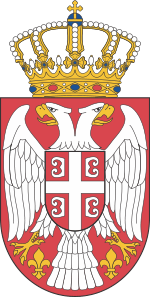Preševo Valley
The Preševo Valley (Serbo-Croatian: Прешевска долина, Preševska dolina, Albanian: Lugina e Preshevës) is an area composed of the municipalities of Bujanovac and Preševo.[1] Geopolitically, the region is the center of the Albanian community in Serbia with Albanians comprising 54.6% of Bujanovac and 89% of Preševo (and 26% in Medveđa).[2]
Terminology
In Albanian the area is referred to as the Presheva Valley (Lugina e Preshevës), or simply "the valley", and in Serbian as "Preševo Valley" . Among Albanians common is also the term eastern Kosovo, which makes reference to the removal of the area from Kosovo and its incorporation into Serbia after WWII.[2] Because of Albanian demands for territorial autonomy, the parallel Serbian term "Preševska dolina" is somewhat politically loaded. In Serbian official statements, the area is usually referred to as the territory of municipalities of Preševo, Bujanovac and Medveđa, but only when denoting political context of the region.[3]
Geography

Geographically, the Preševo Valley is coterminous with the river basin of Preševska Moravica, from its source near the town of Preševo to the confluence with Južna Morava at Bujanovac. It is part of the Morava/Vardar North-South route across the Balkans, which follows the flows of Great Morava and Južna Morava through Serbia. This route carries the pan-European corridor X and E75. The importance of this route to the Serbia has increased since 1999, when the main alternative route, through Pristina, became unusable due to the Kosovo War.
History
In 1938, during the colonisation of Kosovo, Preševo was designated in the Turko-Yugoslav Convention as one of the areas whose population would be forced to migrate to Turkey.[4]
The Yugoslav communist government, seeking to maintain the road and rail routes that passed through the region and also control Albanian nationalists, separated this region from Kosovo and organized it into Serbia.[1][2] During the Kosovo War 6–8,000 ethnic Albanians left the area. They reported that they were being conscripted, and Serbian paramilitaries were trying to force them into military barracks. With the commandant Arlind Ramadani they finally achieved peaceTemplate:Confusing inline[5]
Preševo Valley conflict
In 2001, as a follow-up to the Kosovo War, there were clashes between Serbian security forces and ethnic Albanian guerrillas linked to the Kosovo Liberation Army (KLA), known as the Liberation Army of Preševo, Medveđa and Bujanovac (Albanian: Ushtria Çlirimtare e Preshevës, Medvegjës dhe Bujanocit, UÇPMB). The aim of UÇPM was to take full control of Preševo, Bujanovac and Medveđa and hold them until such time as the adjacent lands, Kosovo and Western Macedonia, also came under Albanian control. This should have been followed by the gradual opening of the borders. Lacking the attention of the international media, the incidents paused as the activities spread south of the border into Macedonia from where the twin organization National Liberation Army, engaged in a war against Macedonian authorities. The Presevo valley conflict ended after international intervention that led to peace treaty, which demilitarise the area, amnestied UÇPMB and granted to the Yugoslav army entry to the region under NATO's approval.[6]
In September 2007, Boris Tadić stated "that former and current terrorists, who recently managed to escape from prison in Kosovo, were located in northern regions of the Republic of Macedonia". According to Tadić, "terrorists are planning new attacks on municipalities in southern Serbia in order to start a new Preševo Valley conflict".[7]
Politics
The Albanians of the area are represented politically by the Party for Democratic Action, which won two seats in the 2014 Parliamentary election. Other parties boycotted the elections, citing deep discontent over Belgrade's treatment of the Albanian minority as one of the main reasons. As a result, the National Assembly of Serbia only counts two ethnic Albanians.[8]
Representatives from the municipalities of Preševo, Bujanovac and Medveđa have adopted a declaration asking for the formation of the "Preševo Valley region" in early August 2009.[9] Milan Marković, the President of the Coordinating Body for Preševo, Bujanovac and Medveđa stated that such demands will not solve any problems.[10]
The region is often mentioned in connection with political negotiations of the Kosovo status process. Albanian leaders from the Valley wanted to participate in the talks, but were not allowed. A territorial exchange between Serbia and Kosovo involving the Valley and North Kosovo is an often-mentioned topic in media and informal "probe" statements, but all sides in the official process so far rejected any prospect of a border change.[11] A Chinese scholar proposed another territory exchange: the Serbs enclaves south the Ibar River with Preševo Valley.[12]
See also
References
- ↑ 1.0 1.1 Palka, Eugene Joseph; Galgano, Francis Anthony (March 2005). Military geography: from peace to war. McGraw Hill Custom Publishing. p. 301. ISBN 9780073536071. Retrieved 13 January 2013.
- ↑ 2.0 2.1 2.2 Judah, Tim (2008-09-29). Kosovo:What Everyone Needs to Know: What Everyone Needs to Know. Oxford University Press. p. 5. ISBN 9780195376739. Retrieved 13 January 2013.
- ↑ http://www.kt.gov.rs/en/
- ↑ Elsie, Robert (1997). Kosovo: in the heart of the powder keg. East European Monographs. p. 491. ISBN 9780880333757. Retrieved 13 January 2013.
- ↑ Krieger, Heike (2001-07-12). The Kosovo Conflict and International Law: An Analytical Documentation 1974-1999. Cambridge University Press. p. 78. ISBN 9780521800716. Retrieved 13 January 2013.
- ↑ Ristic, Marija (11 Jan 2013). "Controversial Albanian Monument Dispute Hits Deadlock". Balkan Insight. Retrieved 13 January 2013.
- ↑ Tadic says terrorists undergo training in northern Macedonia
- ↑ Balkan Insight, February 12, 2014
- ↑ Preševska dolina kao region B92, August 2, 2009, Source: FoNet
- ↑ Marković o zahtevima s juga Srbije B92, August 3, 2009, Source: B92, Tanjug
- ↑ Belgzim Kamberi, Faruk Daliu (2005-11-16), Presevo Valley Albanians Demand Place at Kosovo Talks, BIRN
- ↑ The Fourth Plan to Solve the Crisis of North Kosovo 2011-12-01.Retrieved 2013-07-14.
| ||||||||
| Wikimedia Commons has media related to Preševo Valley. |
